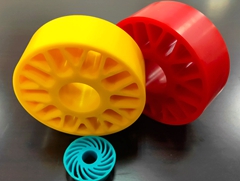Wear resistance and friction coefficient of polyurethane
 The wear resistance and friction coefficient of
polyurethane elastomer are outstanding. Its wear value is generally in the
range of 0.03-0.20m m 3/m (Akron wear), which is much smaller than other
polymer materials, 3-8 times better than natural rubber, and the actual use
effect is often better. The wear resistance of polyurethane elastomer is
determined by its molecular structure and aggregate structure, which is
manifested in the high tear strength, modulus of elasticity, tensile strength,
elongation at break and elasticity of polyurethane elastomer, while the wear
resistance can generally be regarded as the measurement of mechanical
properties such as tear strength of materials. Polyurethane elastomer has
self-lubricating effect, which may be related to the lubricating effect of the
fine powder it abrades. The ground surface is not easy to be hairy, and the
more it is grinded, the smoother it is, showing excellent wear-resistant
effect. However, the wear resistance of polyurethane elastomer is seriously
affected by the surface heat. The surface heat generation is related to the
friction coefficient of polyurethane elastomer, the relative moving speed of
two friction surfaces, the applied external force and whether the friction
surface is dry or wet. The friction coefficient of polyurethane elastomer is
not low, generally above 0.5, but it can be adjusted as wide as the hardness,
as low as 0.2, as high as 2-3, which mainly changes with the hardness. The
higher the hardness is, the smaller the friction coefficient is. The lower the
hardness is, the larger the friction coefficient is. This is related to the
softer the material and the larger the contact surface. The friction
coefficient increases with the increase of the surface temperature, and reaches
the maximum value at about 60 ℃, and then changes little or decreases.
The wear resistance and friction coefficient of
polyurethane elastomer are outstanding. Its wear value is generally in the
range of 0.03-0.20m m 3/m (Akron wear), which is much smaller than other
polymer materials, 3-8 times better than natural rubber, and the actual use
effect is often better. The wear resistance of polyurethane elastomer is
determined by its molecular structure and aggregate structure, which is
manifested in the high tear strength, modulus of elasticity, tensile strength,
elongation at break and elasticity of polyurethane elastomer, while the wear
resistance can generally be regarded as the measurement of mechanical
properties such as tear strength of materials. Polyurethane elastomer has
self-lubricating effect, which may be related to the lubricating effect of the
fine powder it abrades. The ground surface is not easy to be hairy, and the
more it is grinded, the smoother it is, showing excellent wear-resistant
effect. However, the wear resistance of polyurethane elastomer is seriously
affected by the surface heat. The surface heat generation is related to the
friction coefficient of polyurethane elastomer, the relative moving speed of
two friction surfaces, the applied external force and whether the friction
surface is dry or wet. The friction coefficient of polyurethane elastomer is
not low, generally above 0.5, but it can be adjusted as wide as the hardness,
as low as 0.2, as high as 2-3, which mainly changes with the hardness. The
higher the hardness is, the smaller the friction coefficient is. The lower the
hardness is, the larger the friction coefficient is. This is related to the
softer the material and the larger the contact surface. The friction
coefficient increases with the increase of the surface temperature, and reaches
the maximum value at about 60 ℃, and then changes little or decreases.
The friction coefficient (μ) is the ratio of the friction
between the surfaces (f) and the vertical force (n) acting on one of the
surfaces. The static friction coefficient is large, and the dynamic friction
coefficient is also large, and the former is larger than the latter, indicating
that to make the object move in the plane, the starting force is larger than
the force to keep moving. There are many such examples in daily life, which are
not difficult to understand. Friction coefficient is "a double-edged
sword". Some applications need a small coefficient of friction, some
applications need a large coefficient of friction. For example, the friction
coefficient of the rubber fender used in the ship terminal is required to be
small (such as 0.2) to reduce wear. There are transmission gear, sieve plate,
hydrocyclone, scraper, scraper and other products are required to have small
friction coefficient. But the friction drive rubber wheel requires a larger
friction coefficient to drive the passive wheel to rotate. Also, the friction
coefficient of automobile tires should not be small, generally 0.7-1.0. In
particular, the wet friction coefficient is small, and the tire is easy to
slip. In case of emergency, the car can not be braked, which will bring
security risks. In practical application, people will not only make use of the
advantages of large friction coefficient, but also find ways to reduce the
friction coefficient in applications requiring low friction coefficient, and
try to avoid or reduce the harm of sliding friction. For example, rolling
friction drive and gear drive are the best examples to overcome sliding
friction. In addition, in addition to improving the hardness and reducing the
friction coefficient, lubricant, graphite, molybdenum disulfide and
tetrafluoroethylene powder can also be added to further reduce the friction
coefficient of the material and reduce the internal heat, so as to achieve the
best use effect.










